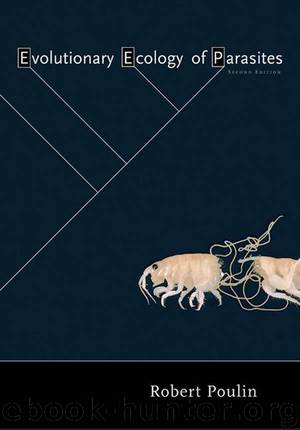Evolutionary Ecology of Parasites by Poulin Robert

Author:Poulin, Robert
Language: eng
Format: epub
Publisher: Princeton University Press
Published: 2007-06-13T16:00:00+00:00
7.3.2 The Nematode Cystidicola cristivomeri
The nematode Cystidicola cristivomeri also has a two-host life cycle. It uses a single species of mysid shrimp, Mysis relicta, as intermediate host. The life cycle is completed after an infected intermediate host is ingested by a suitable fish host (Salvelinus alpinus or S. namaycush). There the nematode migrates to the swimbladder of the host where it matures (Black and Lankester 1980). This parasite is long-lived, and may survive more than ten years in the definitive host. For this reason, the dynamics of infrapopulations do not show seasonal fluctuations but must be examined over longer time spans.
Typically, infected shrimps each harbor a single infective larva. Therefore, a single new recruit is added to an infrapopulation in a fish each time the host consumes an infected prey. In the related C. farionis in a Norwegian population of S. alpinus, the fish host increases its consumption of crustacean prey as it gets older, such that mean infrapopulation sizes increase steadily with fish age (Amundsen et al. 2003). In the Canadian study of C. cristivomeri, however, mysid shrimps are only important food items in the diet of small host fish, and tend to become secondary as fish grow and become increasingly piscivorous. As a consequence, recruitment rates are high in young infrapopulations harbored by young fish hosts, but decrease with age. The pattern observed in natural populations shows an increase in mean infrapopulation size with increasing fish age up to a certain age, which varies among populations in different lakes, after which infrapopulation size stabilizes (Black and Lankester 1981). This probably results from a parasite recruitment rate higher than the parasite mortality rate in the first few years of an infrapopulation’s existence, followed by a period in which both rates are roughly identical until the death of the host.
Whereas infrapopulations may not often reach sizes at which parasite survivorship becomes negatively affected, there is evidence of density-dependent reproductive output in this nematode. Both the proportion of female nematodes reaching sexual maturity and the average length of females are inversely related to infrapopulation size. Since fecundity is strongly correlated with body length in Cystidicola nematodes (Black and Lankester 1981; Black 1985), per capita egg production is therefore reduced in large infrapopulations. Thus both truly density-dependent effects and temporal changes in recruitment rates, which coincide with increases in infrapopulation size but are dependent only on host feeding behavior, contribute to the long-term stability of the nematode population.
Download
This site does not store any files on its server. We only index and link to content provided by other sites. Please contact the content providers to delete copyright contents if any and email us, we'll remove relevant links or contents immediately.
Sapiens: A Brief History of Humankind by Yuval Noah Harari(14163)
The Tidewater Tales by John Barth(12569)
Mastermind: How to Think Like Sherlock Holmes by Maria Konnikova(7162)
Do No Harm Stories of Life, Death and Brain Surgery by Henry Marsh(6839)
The Thirst by Nesbo Jo(6758)
Why We Sleep: Unlocking the Power of Sleep and Dreams by Matthew Walker(6556)
Life 3.0: Being Human in the Age of Artificial Intelligence by Tegmark Max(5404)
Sapiens by Yuval Noah Harari(5263)
The Longevity Diet by Valter Longo(4994)
The Body: A Guide for Occupants by Bill Bryson(4886)
The Rules Do Not Apply by Ariel Levy(4787)
The Immortal Life of Henrietta Lacks by Rebecca Skloot(4447)
Animal Frequency by Melissa Alvarez(4365)
Why We Sleep by Matthew Walker(4317)
The Hacking of the American Mind by Robert H. Lustig(4265)
Yoga Anatomy by Kaminoff Leslie(4248)
All Creatures Great and Small by James Herriot(4189)
Double Down (Diary of a Wimpy Kid Book 11) by Jeff Kinney(4144)
Barron's AP Biology by Goldberg M.S. Deborah T(4062)
